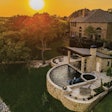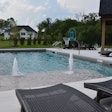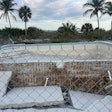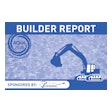
Instead, most people I talk to believe that we’re headed toward a recalibration of homeowners’ views on wealth and prosperity. No longer will conspicuous consumption and ego be the driving forces, but instead homeowners will look for investments with more enduring values.
In terms of landscape and pool construction, this may well mean that many consumers will come to the table with more cautious attitudes and more limited resources. After all, not only has the psychology shifted but also housing prices are still down compared to their zenith and lenders remain reluctant to offer financing to many borrowers. Taken in the aggregate, many people who want aquatic environments will be asking for them with far more limited budgets.
One of the fallacies I’ve always tried to resist is the idea that projects with limited budgets cannot be done well or executed with any sense of artistry. It’s true that a limited budget inevitably leaves some elements out of the mix. We’re not going to see many $50,000 pools with all-tile interiors or elaborate fire features or dancing splash pads. But does that prevent the homeowner from receiving something that is still artfully conceived and well built?
Let me explore that question with a somewhat extreme example. Back when I was editor of WaterShapes, I received a call from a woman who was certain that we should cover her backyard environment in the magazine. She said her pool was “exquisite” and worthy of national media attention. As it turned out, she lived only about 10 miles from my home, so I decided to spend part of a sunny afternoon paying a visit.
To my surprise, the directions led me into a poor part of town where I had never been before, a neighborhood comprised of small ramshackle bungalows and rundown apartments. I found the address and was taken aback by how well maintained the house was. It was small, like the others on the street, but beautifully painted with a lovely garden in the front yard with roses along a weathered picket fence, wind chimes hanging from the eaves and lovely rattan furniture on a small front porch. The woman greeted me warmly as she welcomed me into her home and led me to the backyard.
It was a small yard, probably 30-by-40 feet with beautiful mature fruit trees, palms and a majestic oak. There were effusions of flowering plants, a patio with a large wooden arbor draped in trumpet vines, bird feeders, a small wall fountain and weathered concrete stepping stones coursing through the space.
Tastefully tucked back off to one side was an old-style aboveground Dough Boy pool, like something straight out of the early 70s. Much to the woman’s pride, she had lovingly painted the sides of the pool with images of vines, flowers, birds and butterflies. Rosemary, jasmine and jade were planted around its base almost seamlessly blending with the painted images.
Certainly not what I expected, but in its own folk-artsy way, this was a wonderfully beautiful setting, all nestled amongst the otherwise toxic detritus of urban decay.
We sat on the patio, enjoyed a glass of ice-tea and had a lovely visit. I asked the woman how much had she spent on the whole setting. She thought about it for a moment and said that over that past 15 years she had probably spent no more than $2,500 on the pool, plantings and other materials.
She went on to share that not only was the space, and especially the pool, a point of personal pride, but she had hosted three weddings, a baptism (in the pool) and countless warm days with her extended family there — they’d spent hours lingering in her backyard paradise. Every nook and cranny contained some special touch, from the beautiful paper Japanese lanterns hanging from the beams of the arbor to the handprints of her grandchildren in clay pads by a statue of Kermit the Frog.
After that day, I’ve never thought of modest backyards quite the same way.
I share this story, not to suggest that we start thinking in terms of projects in that price range as a bread-and-butter proposition, but to illustrate the point that even within a bare bones budget, objects of beauty can be created. The value of a living space isn’t necessarily measured in dollars, but in the experiences and narratives it encompasses.
Returning to the $50,000 pool; certainly it can be properly located in the yard to maximize the space and viewing angles. Perhaps it’s a simple rectangle, but many of the world’s most beautiful pools are rectangles; maybe within that budget it might be finished with a beautiful dark plaster and surrounded by plantings to generate reflections. Perhaps the client wants a fire element but instead of an expensive gas-burning feature, you help them find an old iron fire pit. If the space includes a wooden deck, why not make it split level to create different spaces and visual interest?
When you stop and think about it, why can’t the most modest spaces be made beautiful? Sure, it’s wonderful when you’re working with clients with large budgets where you can explore a spectrum of possibilities. But let’s face it, even with a recovering economy those projects are going to remain elusive to many.
Why not learn a lesson or two from the common people that take their small yards and create works of true artistry with otherwise ordinary materials. After all, doesn’t a rose look beautiful whether it’s on the grounds of an estate or next to an aged wooden fence?









































